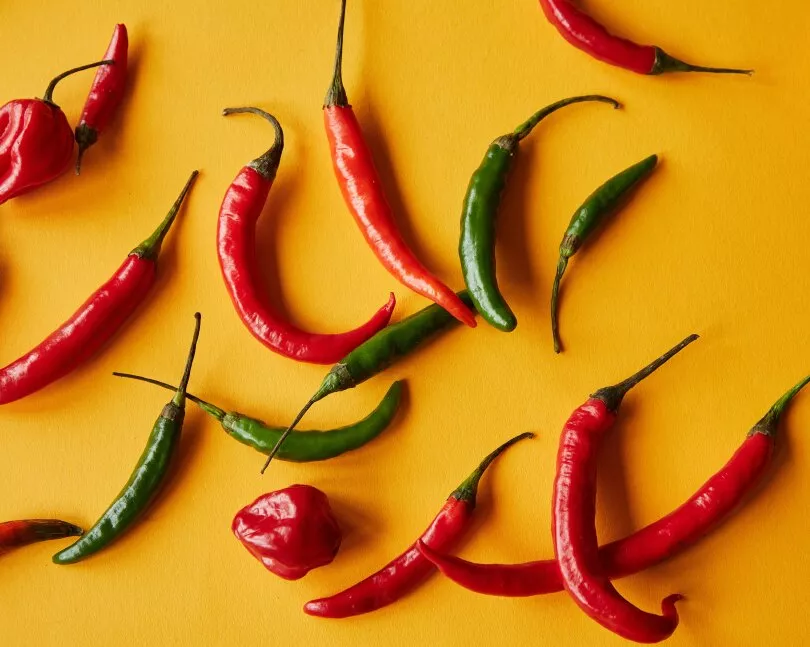Hot stuff: How peppers and wasabi trick your brain into feeling the heat

Have you ever eaten something spicy and wondered why it made your mouth feel like it was on fire?
The answer lies in the compounds in these spicy foods that activate your sensory neurons, causing your brain to think that your body is in contact with a dangerous heat source. In this article, we will dive deeper into the science of spiciness and explore the types of compounds that make some foods spicier than others. We will also provide tips on soothing the burn if you are in pain after eating a spicy meal.
The chemistry of spiciness
Spiciness is commonly referred to as a flavour, but in reality, it does not belong to any of the five basic tastes such as sweet, sour, salty, bitter, and umami. Spiciness is a unique sensation that is caused by specific compounds present in spicy foods.
These compounds activate the polymodal nociceptors, which are sensory neurons present in various parts of the body, including the mouth and nose. These receptors are the same ones that respond to intense heat, and when they are activated by spicy foods, they give rise to a burning or tingling sensation. Therefore, when you consume spicy food like chilli pepper, your brain perceives it as a potentially dangerous heat source, and you feel like your mouth is burning.
What is the Scoville Scale?
The Scoville Scale is a measure of the heat level of chilli peppers and other spicy foods. It was invented by American pharmacist Wilbur Scoville in 1912, who wanted to find a way to measure the heat level of peppers more objectively than simply relying on taste tests.
The Scoville Scale measures the concentration of capsaicin, the chemical responsible for the heat in chilli peppers. The more capsaicin a pepper contains, the higher its Scoville rating. The scale ranges from 0 to over 2 million.
The Scoville Scale is still widely used today, both by food enthusiasts and in scientific research. It is also an important tool in the food industry, as it allows manufacturers to accurately label their products with the appropriate level of spiciness.
How is the Scoville Scale measured?
The Scoville Scale is measured using a process called high-performance liquid chromatography (HPLC). This involves separating the capsaicinoids in a sample of chilli peppers and measuring their concentration.
However, not all chilli peppers are created equal. The heat level of pepper can vary greatly depending on a variety of factors, including its growing conditions, ripeness, and genetics.
To account for these differences, the Scoville Scale is measured using a panel of taste testers. These testers sample a diluted solution of the pepper extract and rate its spiciness on a scale from 0 to 10. The Scoville rating is then calculated based on the dilution factor required to reach this level of spiciness.
What factors influence a pepper's heat level?
As mentioned, a variety of factors can influence the heat level of chilli pepper. Some of these factors include:
- Genetics: Different pepper varieties naturally contain varying levels of capsaicin.
- Growing conditions: Peppers grown in hotter, drier conditions may contain more capsaicin than those grown in cooler, wetter climates.
- Ripeness: As peppers ripen, their capsaicin levels may increase or decrease, depending on the variety.
- Processing: The way peppers are processed can also affect their capsaicin levels. For example, drying or cooking peppers can increase their spiciness.
The Scoville Scale table
| Scoville Scale Rating | Chili Pepper Variety |
| 0 | Bell Pepper |
| 100-900 | Pimento |
| 500-2,500 | Anaheim |
| 1,000-2,000 | Poblano |
| 2,500-8,000 | Jalapeño |
| 10,000-23,000 | Serrano |
| 10,000-30,000 | Black Pepper |
| 30,000-50,000 | Cayenne |
| 50,000-100,000 | Thai |
| 425,000-577,000 | Chocolate Habanero |
This table shows the Scoville Scale ratings for various chilli pepper varieties, from the mild bell pepper at 0 to the extremely hot Carolina Reaper at over 1 million. The Scoville Scale is an important tool for measuring the heat level of chilli peppers and understanding the spiciness of different foods.
What is Wasabi's Scoville score?
The green paste that most people know as wasabi (different from true wasabi) actually comes from a plant that's related to spicy mustard, radishes, and horseradish. This plant produces a chemical called 'allyl isothiocyanate.' This chemical produces a unique kind of spiciness, unlike what you get from chilli peppers. When you cut or grate the plant, it releases chemicals that can really irritate your nose and eyes, giving you that burning sensation.
Because wasabi and peppers have different chemicals that affect our taste buds, the spiciness you feel from wasabi is a distinct experience from the spiciness of peppers and so, we can't measure wasabi on Scoville score. However, if we absolutely had to compare, wasabi would be somewhere between Poblano (1000-2,000 Scoville) and Jalapeno (2,000-8,000 Scoville).
Why does some food feel spicier than others?
The variation in spiciness among diverse types of spicy foods is due to the distinct kinds of compounds present in them.
For instance, capsaicin and piperine, which are present in chilli peppers and black pepper respectively, comprise of bigger and denser molecules termed as alkylamides, which primarily remain in your mouth.
Conversely, mustard, horseradish, and wasabi consist of tinier molecules known as isothiocyanates that can easily ascend into your sinuses. This clarifies why chilli peppers cause a burning sensation in your mouth, whereas wasabi provokes a burning sensation in your nasal cavity.
Why some people can tolerate more spice than others?
When you eat something spicy, your body responds by releasing endorphins—chemicals that act as natural painkillers—to reduce the burning sensation. But why do some people find certain foods spicier than others? Well, it all comes down to our bodies’ heat sensors, called TRPV1 receptors. These receptors are located in our mouth and tongue and help detect temperature to keep us safe from potential harm (i.e., too hot or too cold). They also detect spicy food and send signals to your brain when you consume something with capsaicin in it, causing the familiar “burning” sensation we experience when eating spicy food. People who have more sensitive TRPV1 receptors will find certain foods spicier than those with less sensitive receptors.
Do some people "enjoy" spice even if it makes them uncomfortable?
Despite the pain and discomfort associated with eating spicy foods, some people enjoy the thrill that comes with it. Some studies even suggest that those who enjoy eating spicy foods are more likely to enjoy other adrenaline-rich activities, such as gambling. Additionally, the taste for spicy food may be genetic, with some people being more tolerant of the burn than others. However, it's important to note that according to some studies, the pain associated with eating spicy food does not improve with time. Instead, people who enjoy spicy foods seem to simply enjoy the pain more.
Tips for soothing the burn
If you've ever eaten something too spicy for your taste, you know that it can be an uncomfortable and sometimes painful experience. Fortunately, there are some things you can do to ease the burn and make your mouth feel more comfortable.
-
Drink Milk: Dairy products, such as milk, yoghurt, and cheese, contain a protein called casein that can help neutralise the effects of capsaicin. Drinking a glass of milk or eating some cheese or yoghurt can help soothe the burning sensation in your mouth.
-
Eat Bread or Rice: Starchy foods like bread and rice can help absorb the capsaicin and dilute its effects. Eating a slice of bread or a spoonful of rice can help ease the pain and discomfort of a spicy meal.
-
Drink Water or Other Beverages: While water won't neutralise the effects of capsaicin, it can help wash it away from your mouth and provide some relief. Other beverages that can help include soda, juice, and beer.
-
Try Sugar or Honey: Some people find that eating sugar or honey can help reduce the burning sensation in their mouth. This may be because sugar and honey can help absorb capsaicin and neutralise its effects.
-
Avoid Touching Your Face or Eyes: If you've been eating spicy food, it's important to avoid touching your face or eyes. Capsaicin can easily transfer from your hands to your face, and it can cause a burning sensation and even damage to your eyes.
Adapting to spice levels
The good news is that even if you don't think you can handle very spicy food right now, there are ways to increase your tolerance over time! Eating smaller amounts of spicier dishes will help your body adapt as it gets used to increasing heat levels. You don't need to go from zero-to-100 overnight—start small and work your way up gradually! With enough practice (and plenty of water), you'll be ready for even spicier dishes in no time.
While capsaicin may cause a burning sensation at first, there's no need to fear! Our bodies have evolved so that we can enjoy spice without any harm coming to us –– just make sure you start slow if you're new to spice levels! Whether you like milder flavours or fiery hot dishes, understanding why certain foods taste the way they do can add just a little extra flavour (pun intended!) to whatever dish strikes your fancy. So go ahead –– get out there and explore all the delicious flavours spicy food has to offer!
 SG
SG  VN
VN 












